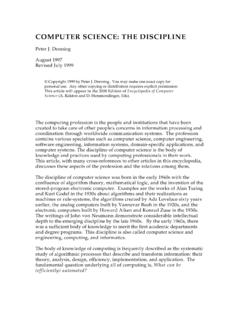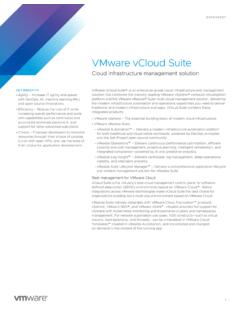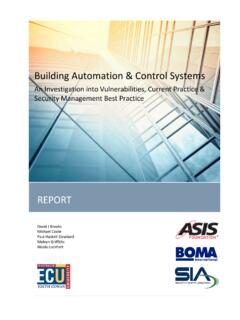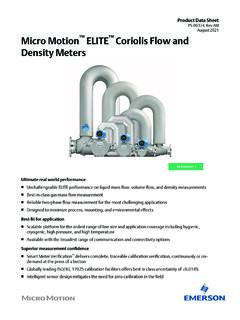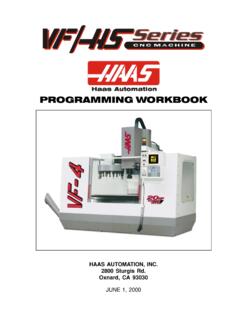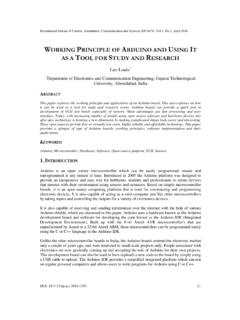Transcription of Automation Principles - DENNING INSTITUTE
1 Copyright 2007 by Peter J. DENNING , with Craig Martell 1 Automation Principles 8/15/07 These Principles concern finding efficient computational ways to perform human tasks. Tasks can be physical, such as running an assembly line, driving a car, controlling airplane surfaces; or mental, such as doing arithmetic, playing chess, and planning schedules. Physical Automation maps hard computational tasks to physical systems that perform them acceptably well. A. The class of very hard computational tasks includes most of the problems people want to solve for business, science, and engineering; for example, figuring route capacities in a transportation network or numerically simulating an aircraft in flight.
2 These problems have all been proved to be NP-hard or worse. B. There is tremendous motivation to find approximate or heuristic ways to solve them, not perfectly but acceptably well. The arrow in the diagram above means that very hard tasks are mapped to simpler Copyright 2007 by Peter J. DENNING , with Craig Martell 2 systems that do good-enough jobs. This is a form of Automation because what was previously beyond reach can now be done well by a machine. It is not unusual for a heuristic system that does consistently well with a (formerly) computationally hard task to be celebrated as a technology breakthrough.
3 C. The artificial intelligence branch of the computing field has developed and studied search processes that reduce very hard tasks to workable ones. For example, a genetic algorithm can generate a set of candidate solutions to the problem and then transform them through several generations of cross-matches and mutations until it evolves a good enough solution. Artificial intelligence maps human cognitive tasks to physical systems that perform them acceptably well. A. In much the same way as physical Automation , the field of artificial intelligence is concerned with mappings from tasks to good-enough systems.
4 In this case the tasks are cognitive tasks of humans and possibly animals. The big difference is that many human tasks are not known to be computational, and therefore solutions cannot start with the assumption they are trying to simplify hard computational problems. B. People in the AI field work with two different hypotheses about human tasks. The strong AI hypothesis holds that human tasks (second diagram) are ultimately computational; they are a subset of hard computational tasks (first diagram). Strong AI seeks to discover the Copyright 2007 by Peter J. DENNING , with Craig Martell 3 computational methods and automate them.
5 The weak AI hypothesis holds that human tasks may not be computational but that we can nonetheless find good-enough computational equivalents. Weak AI seeks to construct computational systems that mimic human tasks acceptably well. C. There has been considerable argument over the validity of the strong AI hypothesis. A famous Chinese Room Argument by John Searle shows that a standard computer that speaks fluent Chinese would be doing nothing more than manipulating symbols without regard to their meaning and would embody no intelligence; therefore a perception by a Chinese speaker that it is intelligent is ungrounded.
6 In practice, this argument is mostly theoretical because most people won t accept that a computational system can perform human tasks unless the system passes a battery of acceptance tests. In other words, they employ the weak AI hypothesis to guide their acceptance even if they worked from the strong AI hypothesis to propose a system. D. Behavioral acceptance tests are used to decide whether a computational system successfully performs human tasks. They compare the observed behavior of the computational system with the observed behavior of humans doing the task. The Turing Test, which compares conversational behavior of humans and machines, was an early example.
7 E. When there is no working good-enough computational system for a human task, we are likely to say: It is a mystery how humans do this, and that s what distinguishes humans from machines. For this task, humans are better than machines. Once an acceptable computational system has been found, we are likely to say: This is clearly not an intelligent task because a machine can do it. For this task, machines are better than humans. In other words, tasks stop looking intelligent when we find computational systems to perform them. F. There are numerous examples of the tendency to hold a task as intelligent as long as no computational method for the task is known.
8 One of the earliest was the game of chess. Early AI researchers thought that finding machines to play chess would be a great accomplishment in the progress of intelligent machines. Today chess programs running on personal computers play at the master level. However, no one thinks the programs are intelligent or even that skill at chess is an intelligent activity. The methods of modern chess programs -- brute force searches of future boards -- do not resemble how the chess masters think when they play. G. The tendency to think technology is unintelligent manifests in many fields, not just artificial intelligence.
9 Arthur Clarke famously said: Any Copyright 2007 by Peter J. DENNING , with Craig Martell 4 sufficiently advanced technology looks like magic. Users of Automation say: Any magical mystery when sufficiently understood looks like advanced technology. Artificial intelligence maps tasks to good-enough computational systems through models, search, deduction, induction, and collective intelligence. A. Modeling means employing (or positing) a model of the intelligent behavior; and then simulating the model with a computer. B. Many computational tasks are hard because the solution requires the algorithm to aggregate components from very large state spaces.
10 Search uses clever heuristics to reduce states included in the solution to a manageable number. C. Deduction means to follow the rules of logic to construct true statements that follow from other, already-known, true statements. D. Induction means to generalize from known statements, data, and evidence to models within which useful deductions can be made. E. Collective intelligence means to aggregate individual knowledge across a network or a game to produce new knowledge and new actions. F. In all five, knowledge representation is a major issue. A representation is a mapping from the current situation (often called a frame or frame of reference) to patterns of symbols obeying a syntax; the semantics (meaning or interpretation) of symbol-patterns is constructed by the observer.
